
The Religious Structures of Woodward Avenue Thematic Resource (TR) is a multiple property submission to the National Register of Historic Places which was approved on August 3, 1982. The structures are located on Woodward Avenue in the cities of Detroit and Highland Park, Michigan.

John Everett Tourtellotte was a prominent western American architect, best known for his projects in Idaho. His work in Boise included the Idaho State Capitol, the Boise City National Bank, the Carnegie Library, and numerous other buildings for schools, universities, churches, and government institutions. From 1922 to 1930, he worked in Portland, Oregon.

The Judge Charles P. McCarthy House is a two-story Prairie school duplex which was constructed in Boise, Idaho in 1913. It was adapted from a Frank Lloyd Wright design published in the April 1907 edition of Ladies Home Journal Magazine, where readers could purchase plans for a flat rate, or have them customized by Wright's office for a 10% premium. It appears as a classic prairie-style design with horizontal design elements, including a low-pitch roof with deep hipped roof overhangs.
Tourtellotte & Hummel was an American architectural firm from Boise, Idaho and Portland, Oregon.

Wayland & Fennell was an architectural firm in Idaho. Many of their works are listed on the U.S. National Register of Historic Places.
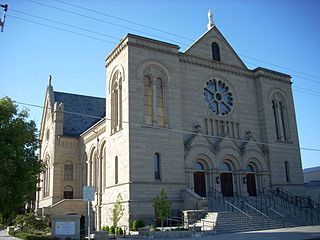
The Cathedral of St. John the Evangelist, also known simply as St. John's Cathedral, is a Catholic cathedral and parish church in the western United States, located in Boise, Idaho. The seat of the Diocese of Boise, the church building was individually listed on the National Register of Historic Places in 1978. It was included as a contributing property of the St. John's Cathedral Block when the rest of the parish buildings on Block 90 were added to the National Register in 1982. That same year, the parish buildings were included as a contributing property in the Fort Street Historic District.
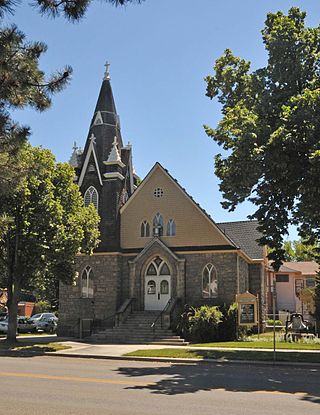
Immanuel Evangelical Lutheran Church is a Lutheran church located in Boise, Idaho. The church was individually listed on the National Register of Historic Places on June 17, 1976. It was included as a contributing property in the Fort Street Historic District on November 12, 1982.

The Capitol Boulevard Memorial Bridge, also known as the Oregon Trail Memorial Bridge, is a historic bridge over the Boise River in Boise, Idaho, United States. It is listed on the National Register of Historic Places.

The Fort Street Historic District in Boise, Idaho, contains roughly 47 blocks located within the 1867 plat of Boise City. The irregular shape of the district is roughly bounded on the north by West Fort Street and on the south by West State Street. The west boundary is North 16th Street, and the east boundary is roughly North 5th Street.

The Carnegie Public Library is a Neoclassical building designed by Tourtellotte & Co. and constructed in Boise, Idaho, in 1904–1905. It was individually listed on the National Register of Historic Places in 1974. In 1982 it was included as a contributing property in the Fort Street Historic District.

The Walter Abbs House, is a Queen Anne style house designed by Tourtellotte & Co. and constructed in Boise, Idaho, USA, in 1903. The five room house is part of the Fort Street Historic District, and it was included as a contributing property on November 12, 1982. It was individually listed on the National Register of Historic Places on November 17, 1982.

The Wolters Double Houses are two similar bungalows designed by Tourtellotte & Hummel and constructed in Boise, Idaho, USA, in 1908 and 1909. Both houses were built from a single duplex design. Part of Boise's Fort Street Historic District, the two houses were listed on the National Register of Historic Places November 12, 1982.
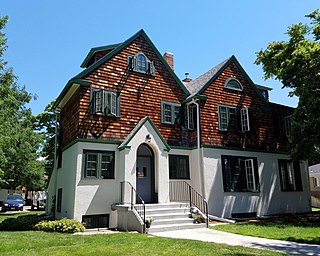
The Samuel Hays House, was designed by an unknown architect and constructed in 1892 for Samuel H. Hays in Boise, Idaho, USA. The house was remodeled by Tourtellotte & Hummel 1926–1927 to include six apartments. Part of Boise's Fort Street Historic District, the house was individually listed on the National Register of Historic Places November 17, 1982. At the time, the Fort Street Historic District also had been listed November 12, 1982.

The John Haines House is a 2+1⁄2-story Queen Anne style house in the Fort Street Historic District of Boise, Idaho. Designed by Tourtellotte & Co. and constructed in 1904, the house features a veneer of rectangular cut stone applied to the first story and shingled, flared walls at the second story. Turrets accent the front two corners of the house, and a classical porch with doric columns and a flattened pediment separates the offset main entrance from the street. It was included as a contributing property in the Fort Street Historic District on November 12, 1982. The house was individually listed on the National Register of Historic Places on November 17, 1982.
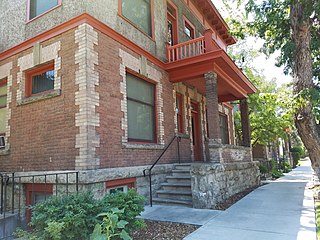
The Eichelberger Apartments in Boise, Idaho, is a 2-story, Colonial Revival building designed by Tourtellotte & Hummel and constructed in 1910. The U-shape, brick and stucco design features corner quoins and keystoned windows with a roofline parapet covered between crested pilasters. It was included as a contributing property in the Fort Street Historic District on November 12, 1982. The building was individually listed on the National Register of Historic Places on November 17, 1982.
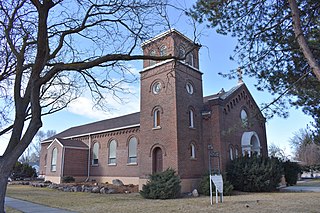
St. Mary's Catholic Church is a red brick, Italianate Romanesque Revival building designed by Tourtellotte and Hummel and constructed by H.J. McNeel in 1925 in Caldwell, Idaho. The church features an 80-ft tower, and the building was added to the National Register of Historic Places in 1982.

The Emerson and Lucretia Sensenig House, also known as the Marjorie Vogel House, is a 2+1⁄2-story Foursquare house in Boise, Idaho, designed by Watson Vernon and constructed in 1905. The house features a hip roof with centered dormers and a half hip roof over a prominent, wraparound porch. Porch and first-floor walls are brick, and second-floor walls are covered with square shingle veneer. A second-story shadow box with four posts is inset to the left of a Palladian style window, emphasized by three curved rows of shingles. The house was added to the National Register of Historic Places in 1997.

The Fred Hottes House in Boise, Idaho, is a 2-story, sandstone and shingle Colonial Revival house designed by Tourtellotte & Co. and constructed in 1908. The house features a cross facade porch and a prominent, pedimented front gable. The house was added to the National Register of Historic Places in 1982.

The Albert Beck House in Boise, Idaho, is a 1+1⁄2-story Queen Anne house designed by Tourtellotte & Co. and constructed in 1904. The house features sandstone veneer on its first floor walls and on a wrap around porch. Overhanging gables with dimpled dormer vents were prominent at the Fort Street and 11th Street exposures. The house was added to the National Register of Historic Places in 1982.
James King was an early architect in Idaho. He was the first formally trained architect operating in the state.



















